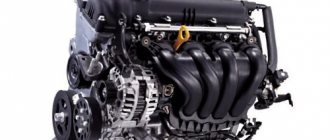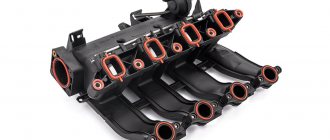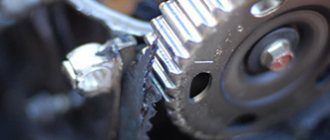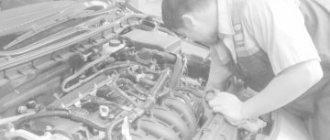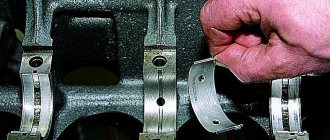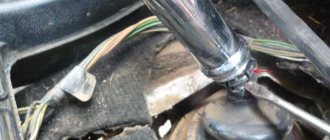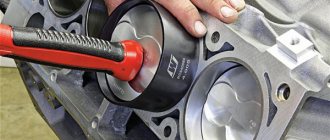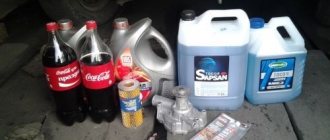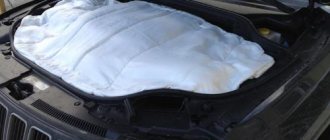During operation, parts of an internal combustion engine are exposed to very high temperatures, and without removing excess heat, its operation is impossible. The main purpose of the engine cooling system is to cool the parts of a running engine. The next most important function of the cooling system is heating the air in the cabin. In turbocharged engines, the cooling system reduces the temperature of the air pumped into the cylinders; in cars with automatic transmissions, it cools the working fluid in the gearbox. In some car models, an oil cooler is installed in the engine lubrication system for additional oil cooling.
Internal combustion engine cooling systems are divided into two main types:
- liquid;
- air.
Each of these systems has its own advantages and disadvantages.
The air cooling system has the following advantages: simplicity of design and maintenance, lighter engine weight, reduced requirements for ambient temperature fluctuations. The disadvantages of air-cooled engines are a large loss of power at the cooling fan drive, noisy operation, excessive thermal load on individual components, the lack of design possibilities for organizing the cylinders according to the block principle, and difficulties with the subsequent use of the rejected heat, in particular for heating the interior.
In modern car engines, an air cooling system is quite rare, and the most common type is a closed-type liquid cooling system.
Design and diagram of a liquid (water) engine cooling system
The liquid cooling system allows you to evenly remove heat from all engine components, regardless of thermal loads. A water-cooled engine is less noisy than an air-cooled engine, less prone to detonation, and warms up faster when starting.
The main elements of the liquid cooling system of both gasoline and diesel engines are:
- “water jacket” of the engine;
- cooling system radiator;
- fan;
- centrifugal pump (pump);
- thermostat;
- expansion tank;
- heater radiator;
- controls.
- The “water jacket” is the communicating cavities between the double walls of the engine in places where excess heat must be removed through the circulation of coolant.
- The radiator of the cooling system serves to release heat to the environment. The radiator is made of a large number of curved (nowadays most often aluminum) tubes, which have additional fins to increase heat transfer.
- The fan is designed to enhance the flow of incoming air to the radiator of the cooling system (works towards the engine) and is turned on by means of an electromagnetic (sometimes hydraulic) clutch from the sensor signal when the threshold value of the coolant temperature is exceeded. Cooling fans with permanent engine drive are quite rare nowadays.
- The centrifugal pump (pump) is used to ensure uninterrupted circulation of coolant in the cooling system of a running engine. The pump is driven from the engine mechanically: by a belt, less often by gears. Some engines, such as engines with turbocharging and direct fuel injection, can be equipped with a dual-circuit cooling system - an additional pump for these units, connected upon command from the electronic engine control unit when a threshold temperature is reached.
- A thermostat is a bimetallic device, or less often an electronic valve, installed between the engine “jacket” and the inlet pipe of the cooling radiator. The purpose of the thermostat is to ensure the optimal temperature of the coolant in the system. When the engine is cold, the thermostat is closed and the coolant circulates “in a small circle” - inside the engine, bypassing the radiator. When the liquid temperature increases to the operating value, the thermostat opens and the system begins to operate in maximum efficiency mode.
- Cooling systems for internal combustion engines are mostly closed systems, and therefore they include an expansion tank that compensates for changes in the volume of liquid in the system when the temperature changes. Coolant is usually poured into the system through the expansion tank.
- A heater radiator is essentially a cooling system radiator, reduced in size and installed inside the car. If the radiator of the cooling system releases heat to the environment, then the heater radiator releases heat directly into the cabin. To achieve maximum efficiency of the heater, the working fluid for it is taken from the system in the “hottest” place - directly at the exit from the engine “jacket”.
- The main element in the circuit of cooling system control devices is the temperature sensor. Signals from it are sent to a control device inside the car, an electronic control unit (ECU) with software configured accordingly, and, through it, to other actuators. The list of these actuators that expand the standard capabilities of a typical liquid cooling system is quite wide: from fan control, to an additional pump relay in engines with turbocharging or direct fuel injection, to the mode of operation of the engine fan after a stop, and so on.
Drawings for RF patent 2400639
The invention relates to mechanical engineering, in particular to engine building, and allows, using the chain reaction of carbon oils with oxygen, to increase power and reduce toxicity in various engine operating modes and at idle.
An oxygen-oil engine is known, containing, similarly to a two-stroke engine, one or more cylinders with intake and exhaust valves, a piston, kinematically connected to a crankshaft, driving a camshaft through gears, equipped with cams driving an oil pump connected to an injector, which delivers a microdose of machine oil when the piston reaches the top point in the cylinder, characterized by the fact that when the piston is at the bottom point, a oxygen-air mixture is supplied from an oxygen cylinder (RF patent 2052149, published on January 10, 1996).
The disadvantages of the known engine are low efficiency and high toxicity of exhaust gases.
The technical result is to increase efficiency and reduce the toxicity of combustion products.
This goal is achieved by the fact that in an oxygen-oil engine containing, similarly to a two-stroke engine, one or more cylinders with intake and exhaust valves, a piston, kinematically connected to the crankshaft, which rotates a camshaft using gears, equipped with cams that drive the oil a pump connected to a nozzle, which supplies a microdose of engine oil when the piston reaches the highest point in the cylinder; when the piston is at the lowest point, an oxygen-air mixture is supplied from an oxygen cylinder and an air filter, while the oxygen-air mixture is replenished at startup from an oxygen cylinder, and in operating condition - through a compressor located in a chamber with a set of molecular sieves and membrane modules that purify atmospheric oxygen from nitrogen, therefore, under pressure, carbon molecules of engine oils are used as fuel, burning with the release of a large amount of heat, while The process of combustion of hydrocarbons in engine oils escalates under high pressure in the compression chamber to the level of explosion in an oxygen-air environment.
The invention is illustrated with the help of drawings.
Figure 1 shows a diagram of an oxygen-oil engine.
Figure 2 shows a diagram of the placement of components that ensure air purification from nitrogen and oxygen supply to replenish the oxygen cylinder and to the intake manifold.
The oxygen-oil engine contains, similarly to a two-stroke engine, one or more cylinders with inlet 1 and exhaust 2 valves (see Fig. 1), a piston 3, kinematically connected to the crankshaft 4, which rotates the camshaft 5, equipped with cams 6. Cams 6 drive the oil pump 7, connected to the nozzle 8, which supplies a microdose of engine oil when the piston 3 reaches the top dead center in the cylinder 9. When the piston 3 is at the bottom dead center, an oxygen-air mixture is supplied from oxygen cylinder 10 and air filter 11. In this case, the oxygen-air mixture is replenished when starting from the oxygen cylinder 10, and during stable engine operation, i.e. in working condition - through the compressor 17 (Fig. 2), located in chamber 13 with a set of molecular sieves 14 and membrane modules 15, which purify atmospheric oxygen from nitrogen. Compressor 17 in automatic mode, with the air valve open (Fig. 1), replenishes the cylinder 10 through pipe 18 with oxygen consumed during startup, and feeds the oxygen-air mixture to the oxygen-oil engine 20 (Fig. 2). Carbon molecules from oils are used as fuel.
The air is enriched with oxygen through a set of sieves and molecular sieves 14. In this case, only partial air processing occurs. Then it enters chamber 13 (Fig. 2), in which membrane modules 16 are installed, where the main purification of the oxygen-air mixture occurs. In this case, the sorted nitrogen is discharged into the atmosphere from the membrane of module 16 through the discharge pipe 22.
The oxygen-air mixture, passing on the way to the compressor 17 through the membrane modules 16, is further enriched with oxygen, and excess nitrogen in the separation chamber of the membrane module before entering the compressor is discharged into the atmosphere through the discharge pipe 22. Nitrogen obtained from the air and returned to the atmosphere does not have any harmful effects on the environment compared to the set of nitrogen compounds obtained in prototypes by burning petroleum products, during which a lot of carbon dioxide is still released.
The processes of compression, intake, expansion and exhaust are similar to those existing in an internal combustion engine, except for the combustion process. Instead, a chain reaction occurs where, in almost pure oxygen, the carbon electrons of engine oils are destroyed at the energy level. The disadvantage of an oxygen-oil engine is the high pressure in the compression chamber, i.e. the compression ratio increases. In addition, the working stroke of the piston from the top to the bottom at the moment of the chain reaction will require a more durable design of the engine block head and cylinders. In addition, to extinguish the explosion at the minimum level of initiation of a chain reaction in the compression chamber, it will be necessary to supply a mixture of oxygen with air, carried out almost manually, during the period of initial experiments.
Unlike existing prototypes, in an oxygen-oil engine the combustion process of engine oil carbons develops under high pressure in the compression chamber 19 to the level of a chain reaction in an oxygen-air environment.
The presence of nitrogen in atmospheric air during combustion gives five compounds (N2 O; N2O2; N2O3; N 2O4; N2O5), where the amount of oxygen per the same amount of nitrogen is related as simple integers 1: 2: 3: 4: 5 respectively. Considering that nitrogen is an inert gas, all reactions of oxygen with nitrogen take place with the absorption of energy, therefore the calculated dosed supply of pure oxygen and air through the intake manifold 15 will allow us to find the desired stable operating mode of the oxygen-oil engine, which is cranked on the stand using an electric motor in the safe conditions of the test site, where people are reliably protected during testing.
The release of energy is controlled by a dosed supply of pure oxygen from a cylinder 10 through a reducer 12 into the intake manifold 15 through a high-pressure pipeline 18 (see Fig. 1). The high explosion energy absorber is the inert gas nitrogen, supplied with air into the combustion chamber 19 through the air filter 11 (Fig. 1). Exhaust gases are discharged through the exhaust manifold 21.
The principle of operation of the cooling system
Only a general, simplified diagram of the operation of the cooling system of an internal combustion engine is given here. Modern engine control systems actually take into account many parameters, such as: the temperature of the working fluid in the cooling system, oil temperature, outside temperature, etc., and based on the collected data, they implement the optimal algorithm for turning on certain devices.
| WE RECOMMEND ALSO READ: |
Share
Share
